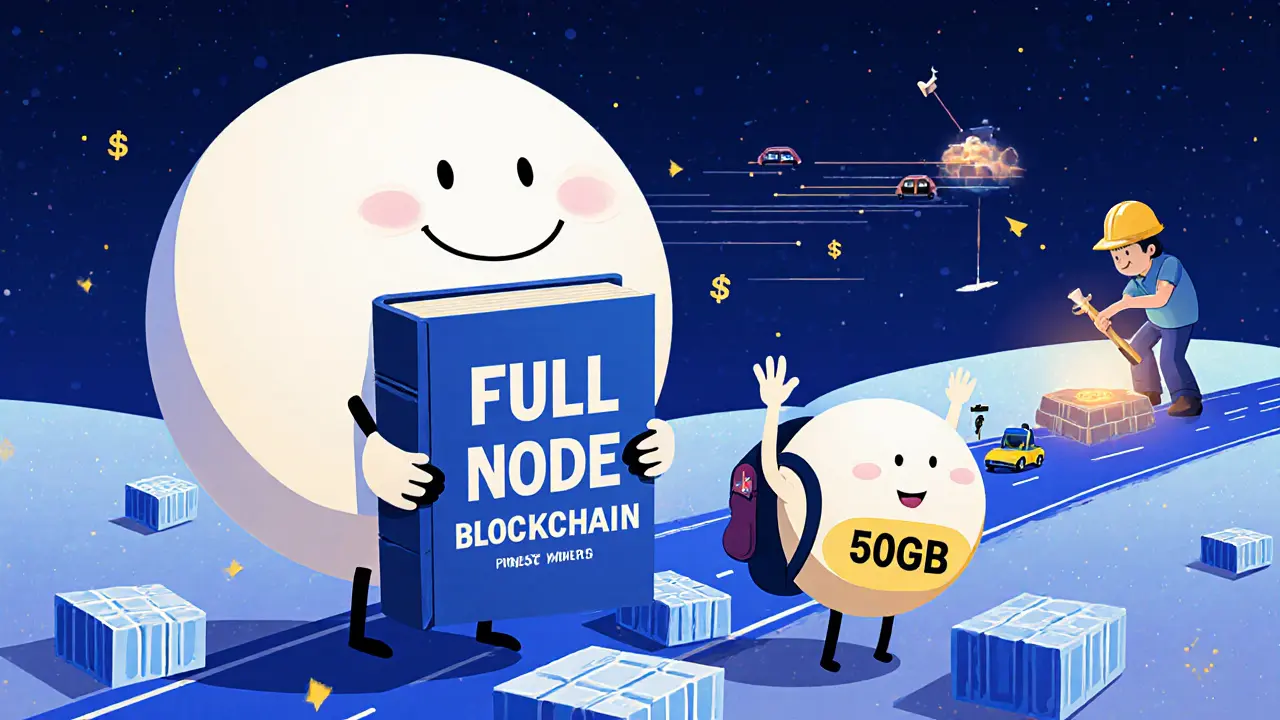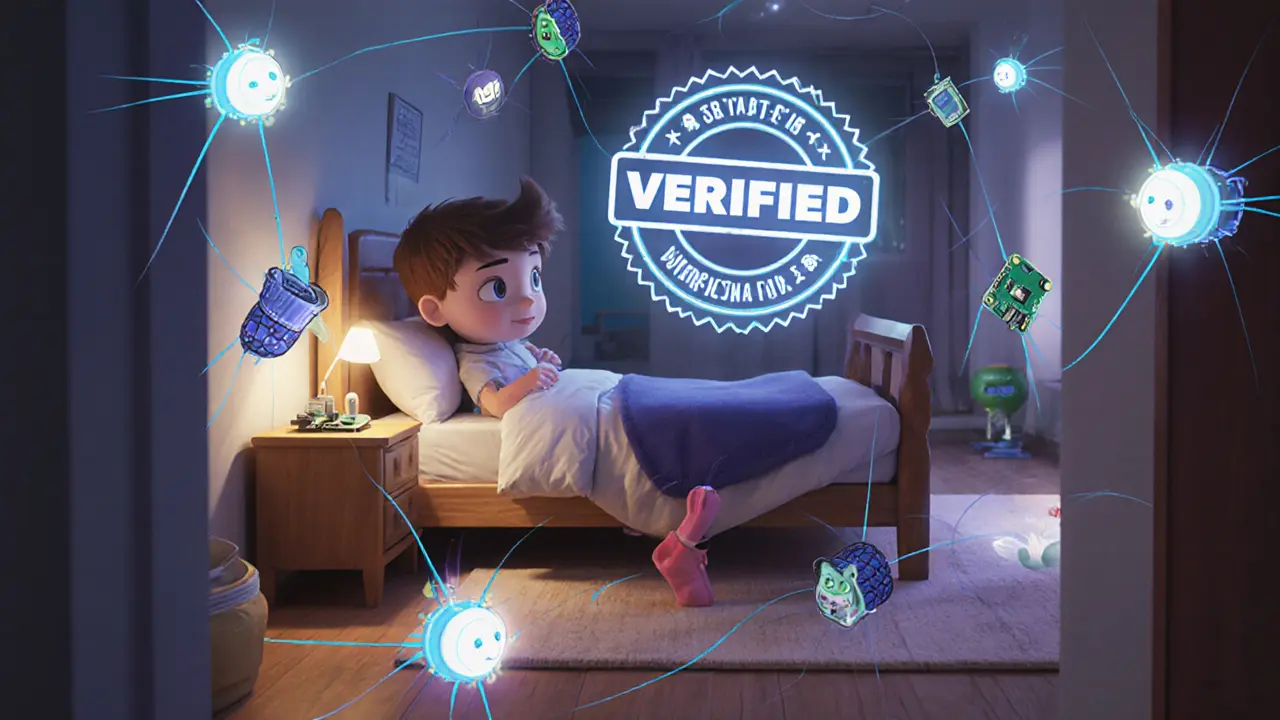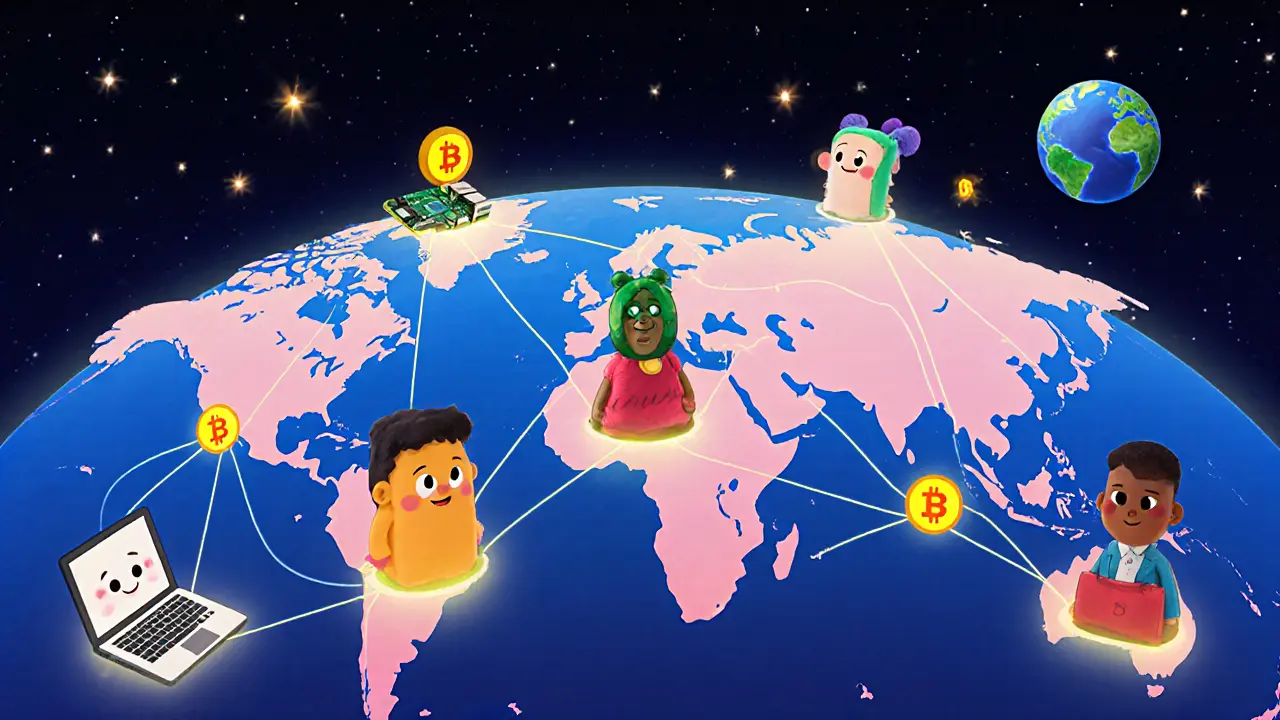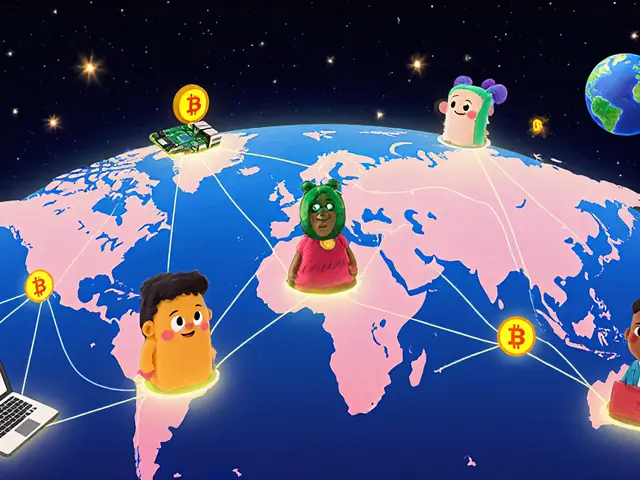Bitcoin P2P Network Quiz
Test Your Knowledge
Answer these questions based on the article content.
1. How many publicly reachable Bitcoin nodes are there?
2. What is the minimum storage requirement for a full node?
3. How do new Bitcoin nodes find the network?
4. What happens if half the nodes are shut down?
5. What is the primary advantage of Bitcoin's P2P design?
Results
Bitcoin doesn’t run on servers owned by banks or tech companies. There’s no central office managing your money. Instead, it runs on a global network of regular computers-yours, mine, someone in Tokyo, someone in Lagos-all talking directly to each other. This is the Bitcoin P2P network, and it’s what makes Bitcoin truly different from anything that came before it.
What Exactly Is a P2P Network?
Think of it like sharing music files in the early 2000s-no central website, no download server. You got files from other people’s computers, and they got files from yours. Bitcoin works the same way, but instead of MP3s, it’s sharing blocks of transactions. Every participant, called a node, is both a client and a server. No one’s in charge. Everyone checks everyone else’s work.
This design isn’t just clever-it’s intentional. Satoshi Nakamoto built Bitcoin this way to remove middlemen. No bank approves your payment. No payment processor takes a cut. The network itself enforces the rules. And it’s been running like this since 2009, without a single point of failure bringing it down.
How Do New Nodes Find the Network?
When you install Bitcoin Core and turn it on, you’re a brand-new node. You don’t know anyone. So how do you connect?
First, your software checks nine different DNS seed servers. These aren’t controlled by one company-they’re run by different developers and organizations around the world. Each one gives you a list of active Bitcoin nodes. If one server goes offline, the others still work. It’s like having nine different phone books for finding people.
If DNS seeds fail (which is rare), your software falls back to a hard-coded list of known good nodes. These addresses are baked into the Bitcoin Core software itself and updated every few months. It’s a backup plan for a backup plan.
Some users even connect through Tor or I2P for extra privacy, hiding their IP address. That’s how the network stays resilient-even if governments try to block access, nodes can still find each other through encrypted tunnels.
What Do These Nodes Actually Do?
Not all nodes are the same. There are two main types: full nodes and pruned nodes.
- Full nodes download and store the entire Bitcoin blockchain-over 500 GB as of 2025. They verify every transaction and block from the very first one in 2009. These are the guardians of the rules. They don’t trust anyone. They check everything themselves.
- Pruned nodes also verify every transaction, but they delete old blocks after checking them. They save storage space (down to around 50 GB) while still being fully secure. You’re still part of the network’s integrity, just not its memory.
Then there are SPV (Simplified Payment Verification) wallets-like mobile apps. These don’t store the whole blockchain. They just ask full nodes for proof that your transaction is real. Faster, lighter, but you’re trusting someone else’s word. Full nodes? You trust only the math.

How Transactions Spread Across the Network
When you send Bitcoin, your wallet doesn’t broadcast it to the whole world at once. It sends it to one or two nearby nodes. Those nodes check it: Is the signature valid? Did you spend the same coins twice? If it passes, they pass it on to their peers. Within seconds, it’s rippling across thousands of nodes.
This relay system is designed to be fast and anonymous. Newer protocols like Dandelion++ even shuffle the path transactions take, making it harder to trace where a payment came from. It’s not perfect, but it’s a big step toward privacy.
Miners pick up these verified transactions and pack them into blocks. Once a block is solved, it’s broadcast to the network. Every full node checks the block’s math-proof of work, transaction list, timestamp. If it’s valid, they accept it. If not, they ignore it. No vote. No CEO. Just code.
Why This Design Is So Strong
Centralized systems-like banks or PayPal-rely on one or two servers. Take those down, and the whole thing stops. Bitcoin? You’d need to take down thousands of computers in dozens of countries at the same time. Even if you shut down half the nodes, the rest keep going.
This is called fault tolerance. And it’s why Bitcoin survived crashes, bans, and hacks. When China cracked down on mining in 2021, the network didn’t collapse. Miners just moved. Nodes kept syncing. Transactions kept flowing.
It’s also why censorship is nearly impossible. If a government tries to block Bitcoin, users can still connect via Tor, or run nodes on cheap hardware like a Raspberry Pi. You don’t need permission. You don’t need approval. You just need an internet connection.

What It Takes to Run a Node
Running a full node isn’t hard, but it’s not casual. You need:
- At least 500 GB of free storage (and growing)
- A decent internet connection-several GB per day
- Time-initial sync can take 1-7 days depending on your hardware
- Basic tech comfort-no need to code, but you should be okay with clicking through a terminal
Most people don’t run full nodes. But the ones who do? They’re the backbone. They ensure the network stays honest. Without them, Bitcoin becomes just another app with a ledger someone else controls.
The Bigger Picture: Bitcoin vs. CBDCs and Other Blockchains
Central bank digital currencies (CBDCs) are digital money-but they’re controlled by governments. They can freeze accounts. They can track every purchase. They need servers. They need permission.
Bitcoin’s P2P network does the opposite. It’s permissionless. It’s censorship-resistant. It’s designed to outlast any single authority.
Other blockchains claim to be decentralized, but many rely on a small group of validators or centralized seed nodes. Bitcoin’s network has over 15,000 publicly reachable nodes, spread across continents, run by individuals, businesses, universities. That’s not just decentralization-it’s resilience built into the bones of the system.
What’s Next for the Network?
Bitcoin’s P2P network isn’t frozen in time. Developers keep improving it. Taproot made transactions smaller and more private. Schnorr signatures are coming to make multi-signature deals more efficient. The Lightning Network, built on top of Bitcoin, lets you send payments instantly without burdening the main chain.
Bandwidth usage is being optimized. Peer discovery is getting smarter. Privacy is improving. But the core idea? Still the same: no central point of control. No single entity with the power to say no.
That’s why, after 15 years, Bitcoin’s network still works. Not because it’s perfect. But because it was built to survive.
Do I need to run a Bitcoin node to use Bitcoin?
No, you don’t need to run a node to send or receive Bitcoin. Most people use wallets like BlueWallet, Electrum, or mobile apps that connect to public nodes. But if you want full control-no third-party trust, no hidden fees, no censorship-running your own node is the only way to be sure.
Can I run a Bitcoin node on a regular laptop?
Yes, you can. A modern laptop with 8 GB of RAM and 500 GB of storage is enough. The biggest hurdle is time-the initial blockchain sync can take days on a slow connection. Once synced, it runs quietly in the background. Many people run nodes on old PCs or Raspberry Pis 4 with external hard drives.
What’s the difference between a full node and a miner?
A full node verifies transactions and blocks. A miner creates new blocks by solving complex math problems. All miners run full nodes, but not all full nodes mine. You can be a full node operator without ever mining. In fact, most full nodes don’t mine-they just help keep the network honest.
Is Bitcoin’s P2P network slow because it’s decentralized?
It’s not slow-it’s deliberate. Bitcoin confirms a transaction in about 10 minutes on average because that’s how long it takes to build a secure block. Speed isn’t the goal. Security and decentralization are. For faster payments, the Lightning Network handles micro-transactions off-chain, while Bitcoin’s main network settles large amounts securely.
Can governments shut down the Bitcoin P2P network?
Technically, no. There’s no single server to shut down. Even if a country blocks Bitcoin traffic, users can still connect via Tor, satellite, or mesh networks. The network has survived bans in China, Nigeria, and Russia. As long as even a few nodes are online somewhere, the network lives. That’s the power of peer-to-peer.


Comments
Bitcoin is just math. No banks. No bosses. Just code.
Simple.
This is the quiet revolution nobody talks about enough. People think crypto is about getting rich, but it’s really about freedom. Running a node feels like joining a global library where everyone’s the librarian and no one owns the books. 🌍📚
I run a pruned node on a Raspberry Pi 4 with an old 1TB drive. It hums away like a contented cat. No drama. No ads. Just validating blocks while I make coffee. Sometimes I stare at the sync progress bar and think-this is what sovereignty looks like. We’re not just using Bitcoin. We’re *becoming* the network. 🤖☕
If you think this is just about money, you’re missing the point. This is about trust being rebuilt from the ground up. No CEO. No board. No middleman taking 3% to say ‘sure, go ahead.’ Just math, code, and a bunch of strangers on the internet who all agree: ‘no one gets to control this.’ That’s powerful.
Oh wow, another ‘Bitcoin is decentralized’ fairy tale. Let me laugh. You really think a handful of mining pools don’t control the hash rate? And those ‘DNS seeds’? Half of them are hosted by known crypto firms with ties to venture capital. And don’t get me started on how ‘open’ the core devs really are. This isn’t decentralization-it’s theater with a blockchain. The truth? It’s just a new kind of oligarchy with more tech jargon.
This whole ‘P2P’ thing is just a distraction. The U.S. government could shut this down tomorrow if they wanted to. All they need to do is block Tor, cut off Bitcoin-related domains, and pressure ISPs. China did it. Russia is trying. And you think some guy in Lagos running a node on a WiFi hotspot is gonna save us? Wake up. This isn’t freedom-it’s a fantasy wrapped in open-source code.
i run a node on my old laptop and it’s kinda meditative? like having a little digital candle burning in the corner. sometimes i forget it’s there until i see a new block pop up. also, i typo’d ‘blockchian’ once and still feel bad about it 😅
I love how this network just… keeps going. In India, we have spotty internet, power cuts, and data caps-but people still run nodes. My uncle uses a Raspberry Pi with a solar charger. He says, ‘If the grid fails, the blockchain won’t.’ And you know what? He’s right. This isn’t tech for the rich. It’s tech for the stubborn. 💪🇮🇳
Full nodes? Please. You’re just a glorified hard drive with an ego. You don’t ‘secure’ the network-you just download a giant file and call yourself a patriot. Meanwhile, real users use wallets. And guess what? They’re fine. You’re not saving Bitcoin. You’re just hoarding data.
The architectural elegance of Bitcoin’s P2P protocol is unparalleled in distributed systems. The use of gossip-based propagation, combined with deterministic validation rules and proof-of-work consensus, creates a Byzantine fault-tolerant environment without requiring trusted third parties. This is not merely a currency-it is a cryptographic social contract implemented in software.
You think this network is decentralized? Lol. The ‘DNS seeds’ are all controlled by Bitcoin Core devs. The ‘hardcoded nodes’? Same people. And the ‘open-source’ code? Only a few people can merge pull requests. This isn’t democracy-it’s a cult with a GitHub repo. And the ‘15,000 nodes’? Most are bots or cloud VMs. Real humans? Maybe 500. The rest are just ghosts in the machine.
I’ve got news for you: Bitcoin doesn’t ‘survive’ bans. It just gets pushed underground where criminals use it. Every time a country cracks down, it’s because people are using it to launder money, evade taxes, or fund terror. You call it ‘resilience.’ I call it a loophole for scumbags. The U.S. needs to shut this down before it becomes a national security threat.
It is imperative to recognize that the Bitcoin peer-to-peer network represents a monumental achievement in decentralized consensus architecture. The absence of centralized control does not equate to chaos; rather, it exemplifies a robust, self-regulating system predicated upon cryptographic integrity and incentivized participation. To operate a full node is to participate in a global civic duty.
Oh, so running a node makes you a ‘guardian of the rules’? Cute. You’re just a glorified server admin with a hobby. Meanwhile, real innovators are building on Layer 2, or better yet, moving to something actually scalable. Bitcoin’s P2P network is a museum piece-impressive, but not the future.
Wait, you say ‘no one controls it’-but then you say the core devs update the hardcoded nodes every few months? So who’s really in charge? The devs? The miners? The people who own the ASIC factories? You’re not decentralized-you’re just hiding the power structure behind fancy words. And don’t even get me started on Tor. That’s not privacy-that’s paranoia with a Wi-Fi connection.
bro i run node on my phone with 4g and its lit 🤯 sometimes when i got no data i just wait till i find free wifi and boom-sync again. bitcoin dont care if u rich or poor. u just need will. and yes i typoed ‘blockchian’ again 😅
I’ve been running a full node for 4 years. I’ve seen bull runs, crashes, bans, memes, and people crying over $500 losses. And you know what? I still wake up every morning and check my node. Why? Because when the world burns, I’ll still be here, validating blocks while everyone else is scrolling TikTok. I’m not a miner. I’m not a trader. I’m just the guy who refuses to trust anyone else with his money. And that’s worth more than any coin.
The beauty of Bitcoin’s network is how it turns passive users into active participants-even if they don’t realize it. Every time you use a wallet that connects to a public node, you’re relying on someone else’s node. That’s why running your own is so important. It’s not about tech-it’s about responsibility. You can’t outsource your freedom.
This is why I hate crypto bros. You all act like running a node is some heroic act. Meanwhile, you’re using a $200 Raspberry Pi you bought on Amazon, syncing a 500GB file you didn’t ask for, and calling it ‘liberty.’ Meanwhile, your electricity bill is higher than your rent. Just use a wallet. Stop pretending you’re saving the world. You’re just a tech hobbyist with a complex.
Let me tell you something-Bitcoin doesn’t need 15,000 nodes. It needs ONE. One honest, unstoppable, untouchable node. The rest? Just noise. The real power isn’t in the network-it’s in the code. And the code? It’s owned by the people who wrote it. You think Satoshi’s ghost is watching you? Nah. He’s laughing at you while he drinks his 2025 Cabernet in the Caymans.
In my culture, we say: ‘The strongest tree is the one that bends in the wind.’ Bitcoin doesn’t break under pressure-it adapts. Tor, I2P, satellite nodes, mesh networks-these aren’t hacks. They’re evolution. This isn’t just a currency. It’s a digital immune system. And the more people join, the harder it is to kill.
So what? You run a node. Big deal. I run a toaster that’s more reliable than my Bitcoin wallet. And let’s be real-how many of these ‘15,000 nodes’ are even real? Probably half are Docker containers in AWS. And the other half? People who think they’re ‘part of the revolution’ while their kids eat instant noodles because they spent their rent on a mining rig. This isn’t freedom. It’s a cult with a blockchain.
You don’t need to run a node to believe in Bitcoin. But if you do, you’re not just using a currency-you’re joining a movement. It’s not about the money. It’s about knowing, deep down, that no one can take your money from you. Not a bank. Not a government. Not even your future self. That’s peace. And that’s worth every gigabyte, every watt of electricity, every day of syncing.
The notion that Bitcoin’s network is truly decentralized is a romantic myth propagated by those who have never questioned the authority of the Core developers. The very DNS seeds, hardcoded nodes, and governance structure are controlled by a small, opaque group. To claim this is ‘resilience’ is to ignore the centralized power structures embedded in its architecture. This is not liberation-it is controlled innovation dressed in libertarian fantasy.
I hear you, Finn. And I’m not blind to the flaws. But here’s the thing: even if the devs have influence, they can’t force anyone to upgrade. If they tried to change the rules, nodes would fork. That’s the beauty of it-the power isn’t in the code. It’s in the choice. I choose to run this node. You choose to run yours. No one owns us. Not even the people who wrote the software. That’s decentralization in action.